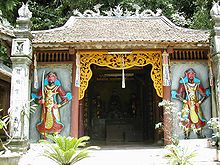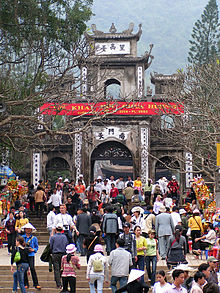- Perfume Pagoda
-
The Perfume Pagoda or Perfume Temple (Vietnamese: Chùa Hương) is a vast complex of Buddhist temples and shrines built into the limestone Huong Tich mountains. It is the site of a religious festival which draws large numbers of pilgrims from across Vietnam.[1] The centre of the Perfume Temple lies in Huong Son Commune, My Duc District, former Ha Tay Province (now Hanoi). The centre of this complex is the Perfume Temple, also known as Chua Trong (Inner Temple), located in Huong Tich Cave.[2]
Contents
Historical background
It is thought that the first temple was a small structure on the current site of Thien Tru which existed during the reign of Lê Thánh Tông in the 15th century. Legend claims that the site was discovered over 2000 years ago by a monk meditating in the area, who named the site after a Tibetan mountain where Lord Buddha practiced asceticism.[3] A stele at the current temple dates the building of a terrace, stone steps and Kim Dung shrine to 1686, during the reign of Le Hy Tong, at around the same time that Chua Trong was being constructed. Over the years some of the structures were damaged and replaced. The original statues of Lord Buddha and Quan Am were cast from bronze in 1767 and replaced with the current statues in 1793[1][2][3]. More recently, damage was done during both the French and the American wars. Both the gate and the bell tower at Thien Tru Pagoda were destroyed, the bell tower rebuilt in 1986 and the gate completed in 1994[1][3].
Physical layout
The many Pagodas that make up Chua Huong are spread out among the limestone hills and tropical forests in the area of Huong Mountain.
Den Trinh
Approaching from the Day River, one will first come across Den Trinh (Presentation shrine), also known as Den Quan Lon (Shrine of High-ranking Mandarin), built to worship one of the generals of a Hung King[1][3][4]. This large shrine has a gate with two kneeling elephant statues on each side. Inside the structure is a large ceremonial room.
Thien Tru Pagoda
Beyond Den Trinh is Thien Tru (Heaven Kitchen) Pagoda, also known as Chua Ngoai (Outer Pagoda). Here one will find Vien Cong Bao Stupa, a brick structure where Ch’an Master Vien Quang, who led the reconstruction of the pagoda, is buried.[3] Thien Thuy stupa, a naturally occurring structure that is the result of the erosion of a rocky hill, is also nearby.[1] Thien Tru is also home to a bell tower and Hall of the Triple Gem, both built in the 1980s. Inside the Pagoda there is a large statue of Quan Am Nam Hai.[2] hay
Giai Oan Pagoda
On the route from Thien Tru to Huong Tich cave is Giai Oan Temple, also called ‘Clearing Unjust Charges’ Pagoda. Here there is a pond called Thien Nhien Thanh Tri (Natural Blue Pond), also called Long Tuyen Well, and Giai Oan stream, with its 9 sources.[3]
Huong Tich Cave
The center of the Chua Huong complex, Huong Tich Cave houses Chua Trong (Inner Temple). The mouth of the cave has the appearance of an open dragon’s mouth with Chinese characters carved in a wall at the mouth of the cave. The characters (Nam thien de nhat dong) are translated as “first grade cave of the South World” and the carving is dated to 1770. The words are attributed by some to the ruler of that time, Thinh Do Vuong Trinh Sam.[1][2] Inside the cave there are many statues. There is a large statue of Lord Buddha, as well as one of Quan Am, both made of a green stone. Quan Am's "left left is stretched out and the foot lies on a lotus flower, her right leg is bent and is supported by a lotus flower with supple leaves; a hand holds a pearl."[2] There are also statues of Arhats and various other figures. Among the naturally occurring features of the cave are numerous stalactites and stalagmites, some of which are worn smooth from years of rubbing by visitors to the cave.[1][5]
Other sites included in the Chua Huong complex are Thien Son Pagoda, Thuyet Kinh Grotto, Phat Tich Temple, and Vong Temple.[1]
Popular practices
There are many practices associated with Chua Huong and its various temples. Some of these are specifically Buddhist, while others are animist or part of popular religion in Vietnam.
Pilgrimage
Many Vietnamese people visit Chua Huong on religious pilgrimage. The standard greetings from one pilgrim to another are "A Di Da Phat"[1] or "Namo Amitabha Buddha"[3]. For the purpose of pilgrimage there are various routes that one might take, but the most popular is to take a boat from Yen wharf, stopping at Trinh shrine to ‘present’ themselves at the ‘registration shrine’. The pilgrims then make their way to Hoi bridge and visit Thanh Son temple inside a cave. The next stop is Tro wharf, from which pilgrims travel on foot to Thien Tru Pagoda. After Thien Tru comes Tien temple, followed by Giai Oan temple. It is believed that Buddha once stopped here to wash himself clean of the dust of humanity, and many pilgrims will wash their face and hands in Long Tuyen Well in hopes of washing away past karmas. While here, pilgrims may also visit Tuyet Kinh cave and Cua Vong shrine to worship the Goddess of the Mountains, or Phat Tich Shrine where there is a stone believed to be the preserved footprint of the Quan Am.[1][2] From here pilgrims head toward the final destination: Huong Tich Cave. At Huong Tich there are statues of deities, but many pilgrims come to get blessings from the stalactites and stalagmites, many of which are named and have special purposes. Many childless pilgrims seek fertility from Nui Co (the girl) and Nui Cau (the boy), while others visit stalactites and stalagmites thought to give prosperity.[2] Pilgrims often gather under one particular stalactite, which resembles a breast, to catch drops of water in hopes of being blessed with health from the ‘milk’ of the 'breast'.[5] Other names of stalactites and stalagmites include the Heap of Coins (Dun Tien), the Gold Tree, the Silver Tree, the Basket of Silkworms (Buong Tam), the Cocoon (Nong Ken) and the Rice Stack (Dun Gao).[1][2]
Festival
The main pilgrimage season at Chua Huong is during the Huong Pagoda festival, when hundreds of thousands of pilgrims make their way to Huong Tich cave and the other temples.[3] The longest lasting festival in Vietnam, it officially begins on February 15 on the lunar calendar, but the peak in visitors lasts from the middle of January to the middle of March.[2] The Festival is seen by some as a good opportunity for young people to find romance and begin courtships.[1]
Popular culture
Legends
There are many legends about Chua Huong and its various pagodas. Huong Tich cave is an especially sacred place because "the legend says that Bodhisatva (Quan Am) went South and stayed at Huong Tich Pagoda in order to help save human souls."[1] A stone at Phat Tich temple is said to be her preserved footprint.[3]
References in literature
One particular legend about Chua Huong has been preserved in a poem by Nguyen Nhuoc Phap. The poem tells the story of a girl who accompanied her father on pilgrimage to Chua Huong and found love while there. The following is a translated excerpt from the poem:
- Oh! Here we are at Trong Pagoda!
- The grotto is hidden in green vegetation:
- Its ceiling is embroidered with stalactites
- Which look like pearls imbued with aquilaria perfume.[3]
Much Vietnamese literature has made Chua Huong its focus, including the following song, written by Chu Manh Trinh:
Delights of Huong Son
- Standing sky high, in the land of Buddhas
- Huong Son is a real wonder we have long wished to see
- With the sight of mountains covered with clouds
- This is undoubtedly "The most beautiful grotto of all"
- Looking up, we can notice a beautiful picture
- Brocaded with sparkling stones rich in colours
- The cave is so deep, glittering in the moonlight
- The entrance path with abrupt turns is so high[3]
Hoang Quy, a popular Vietnamese musician who lived in the early to mid-20th century, sang about the experience of visiting Chua Huong in his song ‘Huong Pagoda’:
- Huong Pagoda is filled with incense and aquilaria
- Smoke spiralling up in the dying sun
- It is the moment when one is held in deep reverie.[3]
References
- ^ a b c d e f g h i j k l m Do Phuong Quynh. Traditional Festivals in Vietnam. Hanoi: Thế Giới Publishers, 1995.
- ^ a b c d e f g h i Ha Van Tan. Buddhist Temples in Vietnam. Hanoi: Social Sciences Publishing House, 1993.
- ^ a b c d e f g h i j k l Sieu, Thich Thien. Vietnam's Famous Pagodas. Ho Chi Minh City: My Thuat Publisher, 1995.
- ^ Tuyet Nhung , "Perfume Pagoda (Chùa Huong) – “the first ranking Southern grotto”." Vietnam-beauty.com. 12 Aug 2008 (accessed March 12, 2009)
- ^ a b Gordon, Grant. "Audio slideshow: Perfume Pagoda Festival." Video. BBC News. Mar. 2008 Accessed February 27, 2009.
Hanoi Historical sites
Public buildings and placesHoan Kiem Lake · Turtle Tower · Temple of Literature · Co Loa Citadel · Thang Long Imperial City · Presidential Palace and Presidential Palace Historical Site · Ho Chi Minh Mausoleum · Flag Tower · Opera House · Hoa Lo Prison
Religious and worship sites Perfume Temple · One-Pillar Pagoda · Tran Quoc Temple · Quan Su Temple
Parks and green areas Museums Occupational villages Other constructions Categories:- Buddhist temples in Hanoi
Wikimedia Foundation. 2010.





